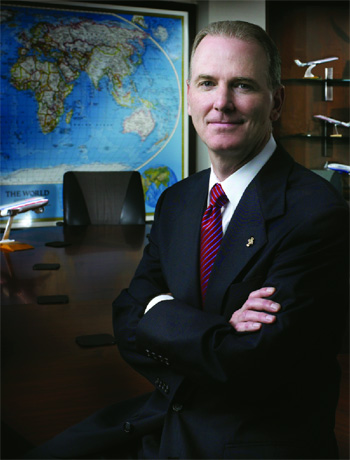As part of this year’s Cox CEO Sentiment Survey, we asked local presidents and CEOs to name the top three still-active CEOs, based on their contributions to their companies and the community. The finalists included such leadership luminaries as Ross Perot (Sr. and Jr.), Jerry Jones, Roger Staubach, and Herb Kelleher. But there could be only one winner: AMR Corporation/American Airlines Inc. chairman, president, and CEO Gerard Arpey.
 |
| American Airlines CEO Gerard Arpey, photographed in his office, July 2007. |
When Arpey took over as head of the world’s largest airline in 2004, he found himself at the yoke of a struggling company, to say the least. American Airlines was experiencing a severe liquidity crisis. With September 11, the Iraq War, and a troubled economy, air travel volumes plummeted and revenues suffered. Nearly all of American’s competitors had fallen into bankruptcy and American seemed sure to follow. In 2002, American’s parent company posted a loss of $1.2 billion, and American was burning through roughly $5 million a day in 2003.
“We teetered on the edge of bankruptcy for all of 2003 and most of 2004,” Arpey says. “We faced the reality that the capital markets had turned off, and we spent a great deal of our time, while trying to plan our longer-term future, trying to figure out how to pay the light bill. That is an experience I would not like to have again.”
The airline’s board had authorized Arpey to file for Chapter 11 bankruptcy. But rather than allowing judges, investment bankers, and lawyers to sort out the company’s future, Arpey worked with his management team to develop a four-point plan that focused on streamlining operations and concentrating on key services, as well as turning inward and looking to employees to help pull the company out of its financial troubles. The airline almost looked as if it were operating like one of its low-cost competitors.
“We developed our turnaround plan, and I think it is a real credit to our unions and employees that they executed that plan,” Arpey says. “That allowed us to rebuild against the strength of the company.”
The strategy slowly began to work, and American turned a profit for the first time in 17 quarters in the second quarter of 2005.
Unlike his flamboyant predecessors, Donald Carty and the iconic Bob Crandall, Arpey’s understated, focused style seems the recipe for leadership needed to steer American through this period in its history. His success seems to have everything to do with his willingness to make decisions best-fit for the company, even if those decisions break with decades of precedent.
American now adopts cost-saving ideas from employees who formerly felt shut out of the company’s decision-making processes. Arpey helped strike a compromise with long-time rival Southwest Airlines to end the Wright Amendment, which had largely benefited American by protecting against cross-town airport competition in Dallas. The CEO has even turned down pay increases to show his commitment to preserving AA’s delicate financial balance.
Now, Arpey is applying this open-minded approach to his work as chairman of the Air Transport Association of America, which is pushing the federal government to update the air traffic control infrastructure in the United States, an issue Arpey believes poses as serious a threat to the industry as the post-9/11 troubles.
In such a volatile industry, Arpey understands the ability to stay innovative and adapt to circumstances is vital, no matter how large and cumbersome an airline company becomes.
“We’re still in the airline business, and the fact of the matter is the airlines business has been historically a very difficult business and it remains so,” Arpey says. “In terms of return on assets, return on equity, and the ability to produce a satisfactory financial result, this is one of the most difficult industries—even in the best of times.”






